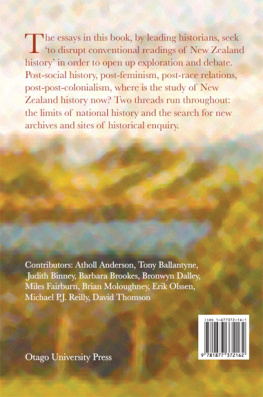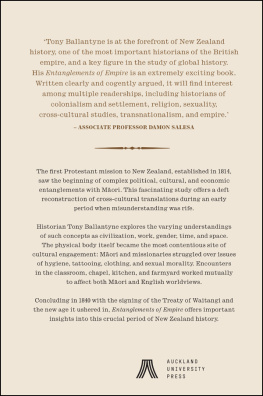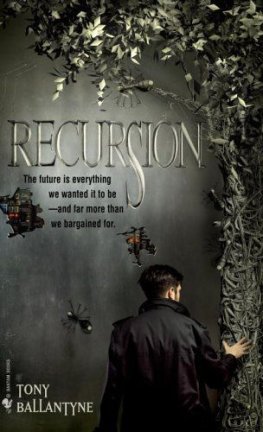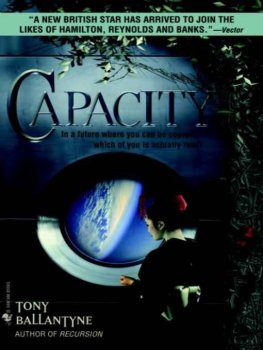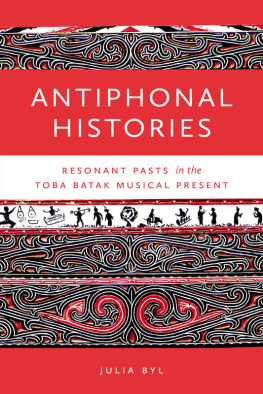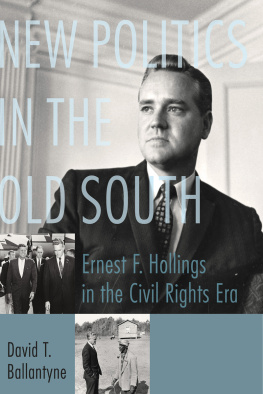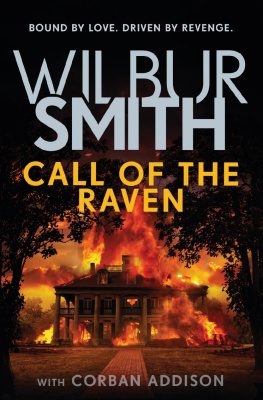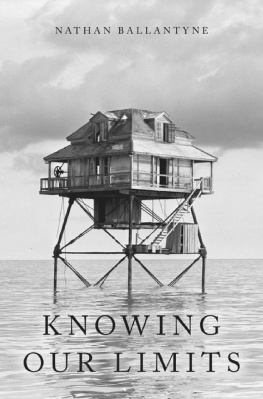Tony Ballantyne - Disputed Histories: Imagining New Zealands pasts
Here you can read online Tony Ballantyne - Disputed Histories: Imagining New Zealands pasts full text of the book (entire story) in english for free. Download pdf and epub, get meaning, cover and reviews about this ebook. year: 2006, publisher: Otago University Press, genre: Romance novel. Description of the work, (preface) as well as reviews are available. Best literature library LitArk.com created for fans of good reading and offers a wide selection of genres:
Romance novel
Science fiction
Adventure
Detective
Science
History
Home and family
Prose
Art
Politics
Computer
Non-fiction
Religion
Business
Children
Humor
Choose a favorite category and find really read worthwhile books. Enjoy immersion in the world of imagination, feel the emotions of the characters or learn something new for yourself, make an fascinating discovery.
- Book:Disputed Histories: Imagining New Zealands pasts
- Author:
- Publisher:Otago University Press
- Genre:
- Year:2006
- Rating:5 / 5
- Favourites:Add to favourites
- Your mark:
- 100
- 1
- 2
- 3
- 4
- 5
Disputed Histories: Imagining New Zealands pasts: summary, description and annotation
We offer to read an annotation, description, summary or preface (depends on what the author of the book "Disputed Histories: Imagining New Zealands pasts" wrote himself). If you haven't found the necessary information about the book — write in the comments, we will try to find it.
Disputed Histories: Imagining New Zealands pasts — read online for free the complete book (whole text) full work
Below is the text of the book, divided by pages. System saving the place of the last page read, allows you to conveniently read the book "Disputed Histories: Imagining New Zealands pasts" online for free, without having to search again every time where you left off. Put a bookmark, and you can go to the page where you finished reading at any time.
Font size:
Interval:
Bookmark:



Published by Otago University Press
PO Box 56/Level 1, 398 Cumberland Street, Dunedin, New Zealand
Fax: 64 3 479 8385. Email:
First published 2006
Volume copyright Tony Ballantyne and Brian Moloughney 2006
Introduction copyright Tony Ballantyne and Brian Moloughney 2006
Individual chapters copyright individual authors as listed on the contents page 2006
ISBN 1-877372-16-1 (print)
ISBN 978-0-947522-25-4 (EPUB)
ISBN 978-0-947522-24-7 (Kindle)
Published with the assistance of the
History Group, Ministry for Culture & Heritage
Front cover: Looking for Mercer, 1990. Oil on board, 550 x 480mm.
Painting by Michael Shepherd. Courtesy of Jane Sanders, Art Agent.
Ebook conversion 2016 by meBooks
In compiling this volume, we have accrued various debts that we would like to acknowledge. The Department of History, Art History and Theory at the University of Otago provided a grant that helped offset some of the production costs. We are thankful for the assistance of Paula Waby, who transcribed the tapes of our interview with Erik Olssen, and Kyle Matthews, who compiled and formatted early versions of the manuscript. We are grateful to Wendy Harrex of the Otago University Press who was an enthusiastic supporter of the project from its inception. We thank Wendy and her staff at the Press for doing such a great job in producing this book. All the contributors responded with good grace to the various demands we made, for which we are grateful. It has been a pleasure to work with them. Finally, we would like to acknowledge our debt to Erik Olssen, who is an inspiring teacher and was a wonderful colleague.
TONY BALLANTYNE & BRIAN MOLOUGHNEY
Dunedin, February 2006
Introduction
Tony Ballantyne & Brian Moloughney
This volume explores new ways of understanding New Zealand history and provides a range of new vantage points on the development of the communities that have made these islands their home. The essays included in the volume not only take stock of New Zealand historiography as it stands today, but also test innovative ways of writing about the past. The authors are searching for new analytical stances, novel ways of framing the temporal and spatial boundaries of our histories, seeking out new- or little-used sources, finding fresh ways of reading old analytical concerns, and critically reflecting upon some of the basic assumptions that govern understandings of New Zealand history. In seeking out and adopting these distinctive angles of vision, the historians contributing to this volume are consciously adopting very specific positions in relation to the broader cultural and political landscapes of life in contemporary New Zealand. Their essays not only tell us much about New Zealands many pasts and how historians have imagined those pasts, but also reflect particular concerns with what New Zealand is now and the role of history as a discipline within our nation at the start of the twenty-first century.
Recent historical writing in New Zealand has been moulded by both international disciplinary currents and the local cultural context within which New Zealand historians have practised their craft. In the mid-1980s, a rather narrow spectrum of concerns and an even more constrained range of approaches marked New Zealand historical writing. By this time, social history, which turned away from the domain of high politics and policy-making to focus on the ways in which race, class, and gender shaped social formations, had emerged as the dominant form of academic history writing. Social history had quickly gained ground from long-established forms of political history and overshadowed economic history, which was more marginal in New Zealand during the 1970s than it had been in the United Kingdom or North America. A wide range of scholars was drawn to social historys promise of writing history from below. Feminist activists and historians saw social history as providing a methodology that would allow them both to restore women to the historical record and to focus attention upon the fundamental structures that had
The other key constellation of research that shaped New Zealand historiography in the mid-1980s was work on race relations. The question of race and the nature of the relationship between New Zealands indigenous populations and colonial settlers had, of course, been a key theme for historians of New Zealand ever since A.S. Thomson produced The Story of New Zealand in 1859. Where the liberal histories of Oliver and Sinclair were ultimately optimistic about the pattern of race relations, with Sinclair suggesting that New Zealand enjoyed better race relations than other settler colonies, this new body of work emphasised Pkeh racism, the centrality of violence to the process of colonisation, and the Crowns contraventions of the Treaty of Waitangi.
The new cultural weight attached to the Treaty and the political and intellectual influence of the Tribunal transformed the kinds of history being produced in New Zealand. Over the past two decades, the Tribunals processes have enabled the production of large bodies of historical scholarship relating to the claims it has considered. While this research has had limited impact on mainstream academic historiography, it stands as a substantial cultural resource that narrates
Outside the claims process, the close collaborative relationship between historians and iwi, and the emphasis given to partnership under biculturalism, shaped the work of some academic writing about nineteenth-century New Zealand history. The complexity and texture of Judith Binneys work on the history of the North Islands east coast was enabled by the close relationships she established with important families in the region and her deft juxtaposition of Mori narratives with the government records, settlers private papers, and Pkeh print culture. Her biography of Te Kooti Arikirangi, Redemption Songs, stands as one of our most compelling and nuanced explorations of the colonial encounter and one of New Zealands outstanding works of biography.
While the work of Binney and Sissons suggested the analytical richness that could be produced out of a close engagement with Mori communities and sources, biculturalism has had the greatest cultural impact when it was harnessed to the story of the nation state and the production of a distinctive vision of national identity grounded on the partnership between Mori and Pkeh. Anne Salmonds work on early contact rematerialised an archive relating to exploration, in order to document the meeting of Two Worlds one Polynesian and one European in New Zealand. All of these works produce compelling stories of productive cross-cultural engagements, place our contemporary identities (as Mori, Pkeh, or New Zealanders) at the forefront of the story, and emphasise the uniqueness of the national past. In Kings case, this vision of a national past made out of the meeting between Mori and Pkeh is given additional popular appeal because of its strikingly optimistic reading of the national character and its faith in the redemptive power of a biculturally inflected liberalism.
This new work on race relations, as well as the rise of social history, was central in initiating a marked shift in the kinds of history that historians of New Zealand were writing and that New Zealanders were reading. In the last decade, we have seen further methodological diversification. Cultural history certainly has developed more slowly in New Zealand than in Australia or North America, largely because of the strength of social history here. The publication of Bronwyn Dalley and Bronwyn Labrums collection
Font size:
Interval:
Bookmark:
Similar books «Disputed Histories: Imagining New Zealands pasts»
Look at similar books to Disputed Histories: Imagining New Zealands pasts. We have selected literature similar in name and meaning in the hope of providing readers with more options to find new, interesting, not yet read works.
Discussion, reviews of the book Disputed Histories: Imagining New Zealands pasts and just readers' own opinions. Leave your comments, write what you think about the work, its meaning or the main characters. Specify what exactly you liked and what you didn't like, and why you think so.

